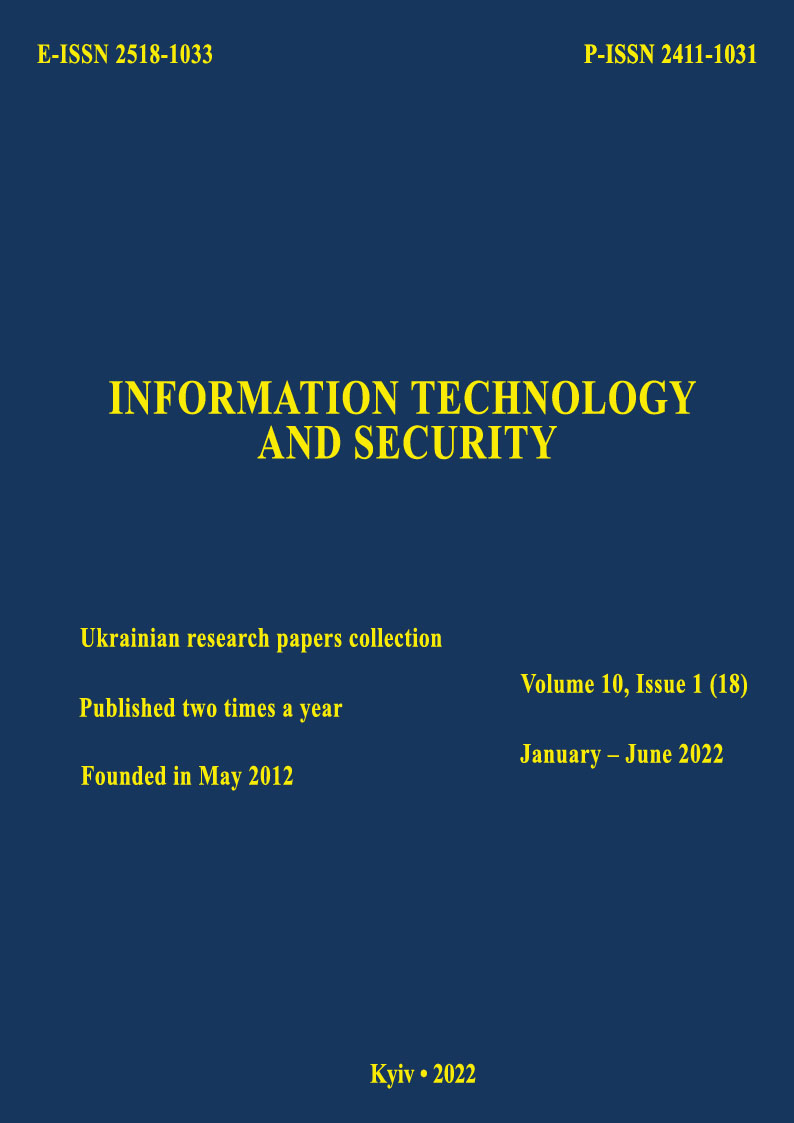Efficiency analysis of routing protocols in wireless mesh networks
DOI:
https://doi.org/10.20535/2411-1031.2022.10.1.261121Keywords:
mesh network, service classes, routing protocols, QoS, JADC2, ITU-T recommendationsAbstract
An important direction in the administration of the state is the creation of a single information environment that will provide reliable feedback, timely planning and coordination of the actions of various units and structures of the state for the effective performance of assigned tasks. These issues are very relevant for the armed forces and other power structures of the state. JADC2 (Joint All-Domain Command and Control) technology was adopted in 2022 as an important strategy in the US armed forces and the armies of NATO countries. It is envisaged that JADC2 will cover all branches of the armed forces in order to combine the communications of various devices in the overall structure of command and control. To achieve success, a constant connection between a large number of domains, including sensors and control objects – Internet of Things in the military sector with the use of artificial intelligence AI/ML (Artificial Intelligence/Machine learning) must be maintained. The communication between the elements of the JADC2 architecture at the respective levels should be provided by different telecommunication networks using different physical channels, such as KH and VHF radio links, satellite communication, fixed fiber optic lines, etc. At the same time, it is necessary to transfer large volumes of data through global networks in a timely manner without losing data integrity, so JADC2 networks must be ready for cyber attacks. To solve these problems, it is necessary to switch from existing conventional radio communication networks to high-speed broadband, including MANET mesh networks (Mobile Ad hoc Network). The main advantages of MANET networks are: deployment speed, low cost with high efficiency, the ability to transmit data over long distances without increasing the transmitter power, resistance to changes in the network infrastructure, the ability to quickly reconfigure in adverse interference conditions. Routing protocols in such networks are the most effective means of solving the problem of service quality. This work presents the results of evaluating the effectiveness of routing protocols in mesh networks in accordance with the requirements of the services provided.
References
I. Demydov, Y. Klymash, M. Brych, and M. Klymash, “The Structural-Functional Synthesis of IoT Service Delivery Systems by Performance and Availability Criteria”, Internet of Things and Engineering Applications, Canada, May, 2017, vol. 2, iss. 1, pp. 1-13, doi: http://dx.doi.org/10.23977/iotea.2017.21001.
A. Karimi, S. Abedini, F. Zarafshan, and S. A. Al–Haddad, “Cluster Head Selection Using Fuzzy Logic and Chaotic Based Genetic Algorithm in Wireless Sensor Network”, Journal of Basic and Applied Scientific Research, no. 3 (4), pp. 694-703, 2013.
J. Ghosh, and A. Acharya, “Cluster ensembles”, Wiley Interdisciplinary Reviews, Data Mining and Knowledge Discovery, vol. 1 (4), pp. 305-315, 2011, doi: https://doi.org/10.1002/9781118445112.stat08170.
P.-J. Chuang, and Y.-J. Jiang, “Effective neural network-based node localisation scheme for wireless sensor networks”, Wireless Sensor Systems, IET, vol. 4, iss. 2, pp. 97-103, 2014, doi: https://doi.org/10.1049/iet-wss.2013.0055.
Cisco Annual Internet Report (2018–2023). [Online]. Available: https://www.cisco.com/c/en/us/ solutions/collateral/executive-perspectives/annual-internet-report/white-paper-c11-741490.pdf. Accessed on: Jan. 15, 2022.
ITU-T Y.1541. [Online]. Available: https://www.itu.int/ITU-T/recommendations/rec.aspx?rec=11462&lang. Accessed on: Jan. 03, 2022.
ITU-T Y.1540. [Online]. Available: https://www.itu.int/rec/T-REC-Y.1540 Accessed on: Jan. 05, 2022.
ITU-T Y.1221. [Online]. Available: https://www.itu.int/rec/T-REC-Y.1221/en. Accessed on: Jan. 27, 2022.
Summary of the Joint All-Domain Command and Control Strategy. Department of Defense USA, March 2022. [Online]. Available: https://https://www.defense.gov/News/Releases/Release/Article/2970094/dod-announces-release-of-jadc2-implementation-plan. Accessed on: Dec. 03, 2021.
S. Ali, and A. Ali, “Performance Analysis of AODV, DSR and OLSR in MANET”, Department of Electrical Engineering with emphasis on Telecommunication Blekinge Institute of Technology, Sweden 2009. [Online]. Available: http://www.diva-portal.org/smash/get/diva2:833565/FULLTEXT01.pdf. Accessed on: Jan. 11, 2022.
N. P. Bobade, and N. N. Mhala, “Performance evaluation of AODV and DSR on-demand routing protocols with varying MANET size”, International Journal of Wireless & Mobile Networks (IJWMN), vol. 4, no. 1, February 2012, doi: http://dx.doi.org/10.5121/ijwmn.2012.4113.
Downloads
Published
How to Cite
Issue
Section
License
Copyright (c) 2022 Collection "Information Technology and Security"

This work is licensed under a Creative Commons Attribution 4.0 International License.
The authors that are published in this collection, agree to the following terms:
- The authors reserve the right to authorship of their work and pass the collection right of first publication this work is licensed under the Creative Commons Attribution License, which allows others to freely distribute the published work with the obligatory reference to the authors of the original work and the first publication of the work in this collection.
- The authors have the right to conclude an agreement on exclusive distribution of the work in the form in which it was published this anthology (for example, to place the work in a digital repository institution or to publish in the structure of the monograph), provided that references to the first publication of the work in this collection.
- Policy of the journal allows and encourages the placement of authors on the Internet (for example, in storage facilities or on personal web sites) the manuscript of the work, prior to the submission of the manuscript to the editor, and during its editorial processing, as it contributes to productive scientific discussion and positive effect on the efficiency and dynamics of citations of published work (see The Effect of Open Access).

